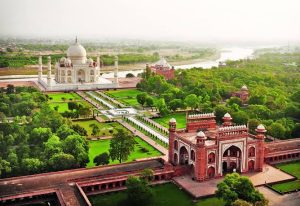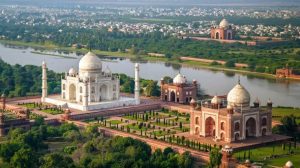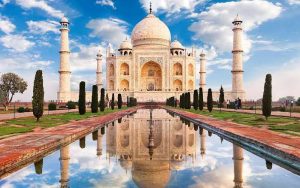Digital News Guru History Desk:
The Taj Mahal, one of the most iconic landmarks in the world, is a symbol of love, artistry, and India’s rich architectural heritage. Located in Agra, Uttar Pradesh, this magnificent white marble mausoleum stands as a testament to Mughal emperor Shah Jahan’s devotion to his wife, Mumtaz Mahal. Built between 1632 and 1653, the Taj Mahal has become not only a UNESCO World Heritage site but also a symbol of India’s historical grandeur.
The Story Behind the Taj Mahal
The story of the Taj Mahal is deeply rooted in love and loss. In 1612, Mumtaz Mahal, the beloved wife of Shah Jahan, passed away during the birth of their fourteenth child. Devastated by her death, Shah Jahan decided to build an extraordinary monument in her memory, one that would symbolize the eternal love they shared. Thus, the construction of the Taj Mahal began in 1632, a year after her death.

The site chosen for the mausoleum was on the banks of the Yamuna River, allowing for a view of the Taj Mahal’s grand architecture reflecting in the water. Shah Jahan’s vision was to create a building so magnificent that it would serve as an eternal tribute to his wife’s memory, blending beauty, symmetry, and harmony in ways never before seen.
Architectural Mastery
The Taj Mahal’s design is a perfect fusion of Persian, Ottoman Turkish, and Indian architectural styles, showcasing the richness of Mughal architecture. The structure is primarily made of white marble, which was sourced from Makrana in Rajasthan, and this marble is inlaid with semi-precious stones, including jade, crystal, turquoise, and lapis lazuli. The Taj Mahal complex is symmetrical, with a large central dome, four minarets at the corners, and a series of elaborate gardens, pools, and pathways.
At the heart of the Taj Mahal lies the central tomb, where the remains of Mumtaz Mahal and Shah Jahan himself are interred. The tomb is topped by a massive dome that rises to about 240 feet, crowned with a lotus design. Surrounding the central structure are four minarets, which serve both decorative and structural purposes, adding balance to the design.
The marble used in the Taj Mahal was chosen not only for its beauty but for its ability to change color depending on the time of day. The monument appears soft pink at dawn, dazzling white under midday sun, and golden at night under moonlight. This ability to transform enhances the mystique of the Taj Mahal, making it a different experience for visitors at different times of the day.
The Taj Mahal Gardens
The Taj Mahal is set within an expansive garden, which is an important part of its architectural concept. The Mughal garden, designed as a “paradise on Earth,” is divided into four parts, symbolizing the four rivers of paradise as described in Islamic texts. These quadrants are laid out with pathways, reflecting pools, and lush greenery, designed to create a tranquil atmosphere. The central reflection pool, which mirrors the Taj Mahal, enhances its visual appeal and magnifies the structure’s grandeur.

The garden is not just decorative but also serves to symbolize the Islamic concept of paradise—an idealized place of peace and beauty. In this sense, the Taj Mahal is not only a mausoleum but also a symbolic garden of eternal life, where the soul of Mumtaz Mahal resides.
The Taj Mahal’s Cultural Impact
Since its completion, the Taj Mahal has attracted millions of visitors from around the globe. Its status as one of the New Seven Wonders of the World and its inclusion in UNESCO’s World Heritage list (1983) has only added to its significance. The monument is not only a masterpiece of architecture but also an enduring symbol of India’s cultural richness and Mughal heritage.
The Taj Mahal has been celebrated in art, literature, and cinema, becoming an inspiration for countless works. Its image is often used in cultural representations of romance and grandeur. The Taj Mahal’s influence extends far beyond India; it is recognized as a universal symbol of love, admired worldwide for its beauty, symmetry, and historical significance.
The Construction and Workforce
The Taj Mahal’s construction employed an extensive workforce of artisans, craftsmen, and laborers from across the Mughal Empire and beyond. Estimates suggest that over 20,000 workers were involved in the creation of the Taj Mahal, including architects, engineers, calligraphers, masons, and inlay artists. The emperor also enlisted the help of Persian and Turkish architects and artisans, which further enriched the Taj Mahal’s design.
One of the most fascinating aspects of the Taj Mahal’s construction is the precision with which it was built. The workers used a combination of sophisticated techniques to ensure that every detail, from the intricate inlay work to the symmetry of the minarets, was perfectly aligned. Many accounts suggest that Shah Jahan ordered the hands of some of the key artisans to be amputated so they could never replicate such a work of art, though this remains a topic of debate.
The Taj Mahal and Its Preservation
Over the centuries, the Taj Mahal has faced numerous challenges, from natural disasters to political instability. In the 18th century, during the reign of the Mughal emperor Aurangzeb, the Taj Mahal began to deteriorate. During British rule, the monument suffered further neglect and damage, though it was saved from ruin thanks to restoration efforts in the 19th century.

In recent decades, air pollution and the increasing urbanization of Agra have posed significant threats to the Taj Mahal’s preservation. The government of India has implemented several measures to protect the monument, including restricting industrial activities around the area and limiting the number of tourists to control foot traffic. The government has also invested in regular cleaning and conservation efforts to maintain the Taj Mahal’s structural integrity and aesthetic beauty.
The Taj Mahal Today
Today, the Taj Mahal stands as one of the most visited tourist destinations in the world. Its cultural, historical, and architectural significance makes it not only a key symbol of India’s heritage but also a universal icon of love and artistry. Every year, millions of people from across the globe travel to Agra to witness this architectural marvel and to reflect on the enduring love story behind it.
The Taj Mahal remains a testament to human creativity, engineering, and the timeless emotions of love and loss. Despite challenges over the centuries, it continues to captivate hearts and minds, reminding the world of the heights that human ambition and devotion can reach.
You May Also Read: Understanding GRAP-IV: What’s Allowed and Banned as Delhi under GRAP-IV








